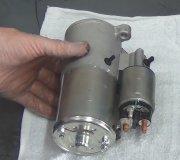First thing I would do is temporarily install a portable pressure gauge with whatever fittings and adapters are necessary in order to get an actual oil pressure PSI reading. (Engine cold about 40PSI / 20-25PSI when warm at idle), and around 40-50 PSI at fast idle (engine warm or cold)).
Those are general "normal" pressure readings.
Your light may be coming on simply due to the pressure switch being faulty. If it has an internal leak, the pressure diaphragm will flex in reaction to the oil pressure, then any oil leaking past the diaphragm can cause counterpressure, causing the diaphragm to relax and relay false readings.
If your pressures with the portable gauge are low, access the oil pump and look for a pressure-relief valve. It has a spring inside and a little piston. It's possible it's opening too early, allowing oil pressure to bypass all the galleys and be dumped back into the pan. Might be a pain in the neck, but remove the spring if you can, expand it a bit, or put in a washer to help create more spring pressure, install again and test oil pressure. That'll require some assembly of the oil pan again, but it beats replacing a whole bunch of bearings if not necessary. Don't caulk the pan. Just install the oil pan and put in about 3-4 quarts of oil and run the engine. Put a large pan underneath to catch leaking oil during the test.
If you feel the bearings are really at fault, get some plastigauge to measure the bearing clearances before you decide on what size bearings to get. Also, if you are at the stage of removing bearings, you should inspect the bearings real carefully: you'll recoginze them being manufactured in layers. If you see layers of metal rubbed off, you'll likely have too much clearance and low oil pressure as a result. I've only seen this in extreme cases in my history of rebuilding engines. Extreme = oil starvation and ruined bearing surfaces. I have yet to see worn bearings simply due to normal wear and tear to the point where I see layers rubbed off. . But anything is possible!
The crankshaft surfaces (where it rotates at the bearing surfaces) need to be shiny and not scratched. If you rub your fingernail perpendicular to the radial scratches and your fingernail gets caught on any particular scratch, your crankshaft needs to be resurfaced. Don't try to bypass this step. Your new bearings will be destroyed within a few miles.
Since the engine is already open, I'd go ahead and remove/replace the main bearings while you're at it. I think a set costs around 50-80 dollars. Maybe less. Shop around.I like using Clevite brand.
You mentioned going undersize. Be careful with this because if you install undersize bearings, they may squash too tight as you torque them down, and the engine will sieze immediately. Only plastigauge can answer your question of which size to use.
Generally, though, crankshafts are made of extremely hard material, the bearing is made of softer. Therefore, any excessive clearance will be as a result of the bearing wearing down. The only time I've used undersize is when I've had the crankshaft cut, and matched to new sets of bearings.
. Enjoy.
Wednesday, March 18th, 2009 AT 7:38 PM


